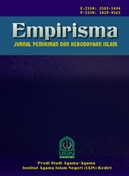Embodied Dzikir: Pengalaman Spiritual Penari Whirling dalam Tarekat Naqsabandiyah Haqqani Rabbani di Indonesia
DOI:
https://doi.org/10.30762/empirisma.v34i1.2998Keywords:
Whirling Dance, Naqshbandiyya Haqqani, Dhikr Ritual, Embodied SpiritualityAbstract
This study aims to describe the practice of whirling dance within the Naqshbandiyya Haqqani Rabbani Order in Indonesia, explore the underlying understanding of its practitioners, and uncover the spiritual experiences associated with this ritual. The central focus is to examine the role of whirling as a form of dynamic dhikr and spiritual transformation within the context of contemporary Sufi practices. This research employs a qualitative approach with a phenomenological method. Data were collected through participant observation and in-depth interviews with whirling dancers affiliated with the Naqshbandiyya Haqqani Rabbani community. The analysis focused on the dancers' subjective experiences and spiritual reflections during the practice. The findings reveal three main points. First, the whirling dance in the Naqshbandiyya Haqqani context is not merely an artistic expression but a structured, symbolic ritual of dhikr, representing the cosmic movement toward unity with the Divine. Second, the dancers possess a deep Sufi understanding of the dance, interpreting it as a manifestation of fana (self-annihilation) and ego transcendence. Third, the spiritual experience during whirling touches on core elements of Sufi psychology—qalb (heart), nafs (soul), and ruh (spirit)—resulting in observable changes in behavior, inner tranquility, and enhanced daily dhikr quality. Theoretically, these findings contribute to the discourse of contemporary Sufism, particularly concerning the role of embodied expressions in dhikr rituals and the relevance of embodied spirituality approaches in the study of Islamic mysticism. The whirling dance exemplifies the integration of bodily movement and spiritual consciousness along the Sufi path.
Downloads
References
Asbury, M. E. “Naqshbandi Mujaddidi Mysticism in the West: The Case of Azad Rasool and His Heirs. Religions, 13 (8), 690,” 2022.
Buehler, Arthur F. Sufi Heirs of the Prophet: The Indian Naqshbandiyya and the Rise of the Mediating Sufi Shaykh. Univ of South Carolina Press, 1998.
Chittick, William C. Faith and Practice of Islam: Three Thirteenth-Century Sufi Texts. State University of New York Press, 1992.
———. The Sufi Path of Knowledge: Ibn al-ʿArabi’s Metaphysics of Imagination. State University of New York Press, 2010.
Cizmeci, Esra. “World as Sacred Stage for Sufi Ritual: Performance, Mobilization and Making Space with the Act of Whirling.” Dance, Movement & Spiritualities 3, no. 3 (September 1, 2016): 199–215. https://doi.org/10.1386/dmas.3.3.199_1.
Creswell, John W., William E. Hanson, Vicki L. Clark Plano, and Alejandro Morales. “Qualitative Research Designs: Selection and Implementation.” The Counseling Psychologist 35, no. 2 (March 1, 2007): 236–64. https://doi.org/10.1177/0011000006287390.
Estuningtiyas, Retna Dwi. “Eksistensi Tarekat Naqsyabandi Haqqani Di Jakarta.” The International Journal of Pegon : Islam Nusantara Civilization 7, no. 01 (June 20, 2022): 53–71. https://doi.org/10.51925/inc.v7i01.58.
Ezzy, Douglas. Qualitative Analysis. London: Routledge, 2013. https://doi.org/10.4324/9781315015484.
Frembgen, Jürgen Wasim. “DHamāl and the Performing Body: Trance Dance in the Devotional Sufi Practice of Pakistan*,” January 1, 2012. https://doi.org/10.1163/221059512X626126.
Gazali, Gazali. Tarekat Naqsyabandi Haqqani Di Indonesia. Deepublish, 2015. https://repository.deepublish.com/publications/588895/.
Ha, Guangtian. “Dialectic of Embodiment: Mysticism, Materiality and the Performance of Sufism in China.” Text. Intellect, May 2014. https://doi.org/10.1386/pi.3.1-2.85_1.
Harel, Keren, Johanna Czamanski-Cohen, and Nataly Turjeman. “The Spiritual Experience of Sufi Whirling Dervishes: Rising Above the Separation and Duality of This World.” The Arts in Psychotherapy 75 (September 1, 2021): 101831. https://doi.org/10.1016/j.aip.2021.101831.
Huq, Tasneem. “Dancing and Poetry: A Study of the Whirling Dervish Dance Through Rumi’s Poetry.” Honors Program: Theses, March 10, 2022. https://digitalcommons.unl.edu/honorstheses/413.
Kamaruzaman, Mohd Asyran Safwan, Mohd Haidhar Kamarzaman, and Kamarudin Salleh. “THE DA’WAH OF SYEIKH NAZIM AL-QUBRUSI: BETWEEN THE ACCEPTANCE AND REJECTION.” Al-Hikmah 11, no. 1 (June 15, 2019): 41–59.
Kugle, Scott. Sufis and Saints’ Bodies: Mysticism, Corporeality, and Sacred Power in Islam. Univ of North Carolina Press, 2011.
Mahmood, Saba. “Agency, Gender, and Embodiment.” In Religion in Today’s World. Routledge, 2013.
McClure, Hanna. “The Whirling Sema Ritual and Performance Practitioners: Issues of Authenticity Change, and East–West Exchange.” Congress on Research in Dance Conference Proceedings 2016 (October 2016): 251–59. https://doi.org/10.1017/cor.2016.34.
Meiring, Arnold Maurits. “Rumi Whirling in a Secular Age : Applying Medieval Sufi Wisdom to the Questions of Our Day,” December 17, 2021. https://repository.up.ac.za/handle/2263/87143.
Norouzitalab, Alireza, and Padideh Adelvand. “The Comparative Study of ‘Shiva’ Dance and ‘Sufi Whirling’ Dance.” The Monthly Scientific Journal of Bagh-e Nazar 11, no. 28 (March 1, 2014): 15–24.
Nurwendah, Yusti Dwi, Najib Kailani, and Wening Udasmoro. “Religious Soundscape, Sacred Space, and Affective Body: The Experience of Sufi Whirling Ritual Practitioners in Java.” Teosofi: Jurnal Tasawuf Dan Pemikiran Islam 14, no. 1 (June 1, 2024): 145–62. https://doi.org/10.15642/teosofi.2024.14.1.145-162.
Ortiz, Anna M. “The Qualitative Interview.” In Research in the College Context, 2nd ed. Routledge, 2015.
Pambuka, Fian Rizkyan Surya, and Ahmad Saifuddin. “Whirling Dance as a Sufi Healing Method: A Phenomenological Study of the Sufi Dance Community in Surakarta.” Teosofi: Jurnal Tasawuf Dan Pemikiran Islam 13, no. 2 (February 24, 2024): 204–31. https://doi.org/10.15642/teosofi.2023.13.2.204-231.
Pinto, Paulo G. “Mystical Bodies/Unruly Bodies: Experience, Empowerment and Subjectification in Syrian Sufism.” Social Compass, June 1, 2016. https://doi.org/10.1177/0037768616628791.
Rodrigues, Jamila. Sufi Women, Embodiment, and the ‘Self’: Gender in Islamic Ritual. London: Routledge, 2022. https://doi.org/10.4324/9780429353574.
Schimmel, Annemarie. Mystical Dimensions of Islam. The Other Press, 2008.
Smit, Brigitte, and Anthony J. Onwuegbuzie. “Observations in Qualitative Inquiry: When What You See Is Not What You See.” International Journal of Qualitative Methods 17, no. 1 (December 1, 2018): 1609406918816766. https://doi.org/10.1177/1609406918816766.
Sunarto, Sunarto, and Robby Habiba Abror. “Orchestrating Sufism: The Transculturation of Ottoman Aesthetic Traditions in Indonesian Muslims.” ESENSIA: Jurnal Ilmu-Ilmu Ushuluddin 23, no. 1 (August 17, 2022): 79–90. https://doi.org/10.14421/esensia.v23i1.3141.
Trimingham, J. Spencer. The Sufi Orders in Islam. Oxford University Press, 1998.
Turner, Bryan S. Religion and Modern Society: Citizenship, Secularisation and the State. Cambridge University Press, 2011.
Ware, Rudolph T. The Walking Qur’an: Islamic Education, Embodied Knowledge, and History in West Africa. UNC Press Books, 2014.
Werbner, Pnina, and Helene Basu. “The Embodiment of Charisma.” In Embodying Charisma. Routledge, 1998.
Widiyanto, Asfa. “Spirituality Amidst the Uproar of Modernity: The Ritual of Dhikr and Its Meanings among Members of Naqshbandy Sufi Order in Western Europe.” Al-Jami’ah: Journal of Islamic Studies 44, no. 2 (December 30, 2006): 251–74. https://doi.org/10.14421/ajis.2006.442.251-274.
Yusuf, Falahul Mualim. “Strategi komunikasi komuniitas cafe rumi jakarta dalam menanamkan nilai-nilai tasawuf di masyarakat perkotaan.” bachelorThesis, Jakarta : Fakultas Ilmu Dakwah dan Ilmu Komunikasi UIN Syarif Hidayatullah, 2017. https://repository.uinjkt.ac.id/dspace/handle/123456789/40197.
Downloads
Published
How to Cite
Issue
Section
License
Copyright (c) 2025 Ahmad Ridwan, Sururin, Arif Zamhari

This work is licensed under a Creative Commons Attribution-NonCommercial-ShareAlike 4.0 International License.














 This work is licensed under a
This work is licensed under a 








